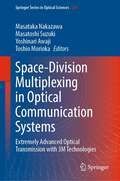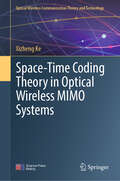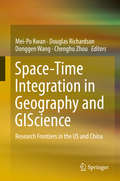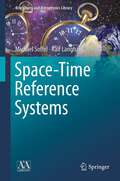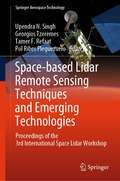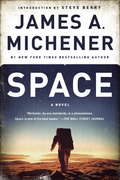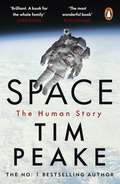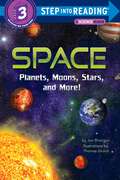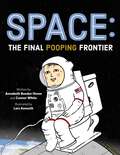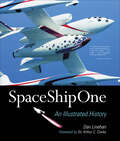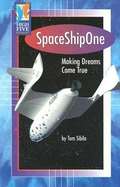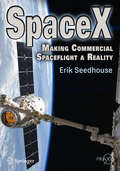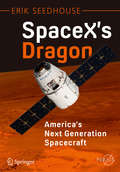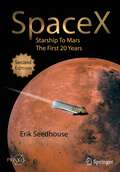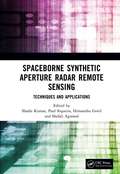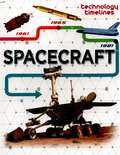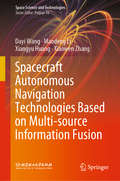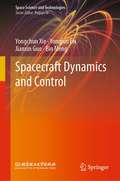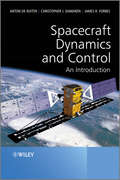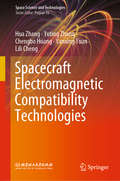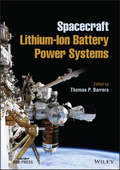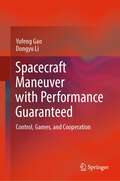- Table View
- List View
Space-Division Multiplexing in Optical Communication Systems: Extremely Advanced Optical Transmission with 3M Technologies (Springer Series in Optical Sciences #236)
by Masataka Nakazawa Masatoshi Suzuki Yoshinari Awaji Toshio MoriokaThis book presents new frontiers in data communication. To transcend the physical limitations of current optical communication technologies, totally new multiplexing schemes beyond TDM/WDM, novel transmission optical fibers handling well above Pbit/s capacity, and next-generation optical submarine cable systems will need to be developed. The book offers researchers working at the forefront, as well as advanced Ph.D. students in the area of optical fiber communications systems and related fields, an essential guide to state-of-the-art optical transmission technologies. It explores promising new technologies for the exabit era; namely, the three “M technologies”: multi-level modulation, multi-core fiber, and multi-mode control.
Space-Time Coding Theory in Optical Wireless MIMO Systems (Optical Wireless Communication Theory and Technology)
by Xizheng KeThis book is divided into 12 chapters, including introduction, multi-aperture transmit/receive technology in turbulent atmosphere, channel model and channel capacity, orthogonal space-time block coding, layered space-time coding, hybrid space-time coding, space-time trellis coding, differential space-time coding, unitary space-time coding, adaptive layered space-time coding, performance analysis of indoor MIMO-VLC system, and detection algorithm of MIMO technology. The key technologies of wireless optical MIMO systems are introduced, and the basic framework of space-time coding of wireless optical MIMO systems is proposed.
Space-Time Geometries for Motion and Perception in the Brain and the Arts (Lecture Notes in Morphogenesis)
by Alain Berthoz Tamar FlashThis book is based on a two-day symposium at the Paris Institute of Advanced Study titled "space-time geometries and movement in the brain and the arts". It includes over 20 chapters written by the leading scientists and artists who presented their related research studies at the symposium and includes six sections; the first three focus on space-time geometries in perception, action and memory while the last three focus on specific artistic domains: drawing and painting, dance, music, digital arts and robotics. The book is accompanied by a dedicated webpage including related images and videos. There is an ever-growing interest in the topics covered by this book. Space and time are of fundamental importance for our understanding of human perception, action, memory and cognition, and are entities which are equally important in physics, biology, neuroscience and psychology. Highly prominent scientists and mathematicians have expressed their belief that our bodies and minds shape the ways we perceive space and time and the physical laws we formulate. Understanding how the brain perceives motion and generates -bodily movements is of great significance. There is also growing interest in studying how space, time and movement subserve artistic creations in different artistic modalities (e.g., fine arts, digital and performing arts and music). This interest is inspired by the idea that artists make intuitive use of the principles and simplifying strategies used by the brain in movement generation and perception. Building upon new understanding of the spatio-temporal geometries subserving movement generation and perception by the brain we can start exploring how artists make use of such neuro --geometrical and neuro-dynamic representations in order to express artistic concepts and emotionally affect the human observers and listeners. Scientists have also started formulating new ideas of how aesthetic judgements emerge from the principles and brain mechanisms subserving motor control and motion perception.Covering novel and multidisciplinary topics, this advanced book will be of interest to neuroscientists, behavioral scientists, artificial intelligence and robotics experts, students and artists.
Space-Time Integration in Geography and GIScience
by Donggen Wang Chenghu Zhou Mei-Po Kwan Douglas RichardsonSpace-time analysis is a rapidly growing research frontier in geography, GIS, and GIScience. Advances in integrated GPS/GIS technologies, the availability of large datasets (over time and space), and increased capacity to manage, integrate, model and visualize complex data in (near) real time, offer the GIS and geography communities extraordinary opportunities to begin to integrate sophisticated space-time analysis and models in the study of complex environmental and social systems, from climate change to infectious disease transmission. This volume specifically focuses on research frontiers, comparative research, and research and application interactions in this field in the US and China, arguably the two most dynamic loci for this work today. The contributions to this book, by top researchers in China and the US, productively highlight the differences and similarities in approaches and directions for space-time analysis in the two countries. In light of the recent rapid progress in GIScience research on space-time integration in both countries, the book's focus on research frontiers in these two countries will attract great interest in both countries and in other parts of the world as well as among related disciplines. In addition, the book also explores the impact of collaborative research and publications underway in this area between the US and China and will provide an overview of these collaborative efforts and programs. This book will not only be of interest to university-based GIS researchers and students, but also to those interested in this new area of research and applications like researchers and developers in business, internet mapping and GIS and location based services (LBS).
Space-Time Reference Systems
by Michael Soffel Ralf LanghansThe high accuracy of modern astronomical spatial-temporal reference systems has made them considerably complex. This book offers a comprehensive overview of such systems. It begins with a discussion of 'The Problem of Time', including recent developments in the art of clock making (e.g., optical clocks) and various time scales. The authors address the definitions and realization of spatial coordinates by reference to remote celestial objects such as quasars. After an extensive treatment of classical equinox-based coordinates, new paradigms for setting up a celestial reference system are introduced that no longer refer to the translational and rotational motion of the Earth. The role of relativity in the definition and realization of such systems is clarified. The topics presented in this book are complemented by exercises (with solutions). The authors offer a series of files, written in Maple, a standard computer algebra system, to help readers get a feel for the various models and orders of magnitude. Beyond astrometry, the main fields of application of high-precision astronomical spatial-temporal reference systems and frames are navigation (GPS, interplanetary spacecraft navigation) and global geodynamics, which provide a high-precision Celestial Reference System and its link to any terrestrial spatial-temporal reference system. Mankind's urgent environmental questions can only be answered in the context of appropriate reference systems in which both aspects, space and time, are realized with a sufficiently high level of accuracy. This book addresses all those interested in high-precision reference systems and the various techniques (GPS, Very Long Baseline Interferometry, Satellite Laser Ranging, Lunar Laser Ranging) necessary for their realization, including the production and dissemination of time signals.
Space-based Lidar Remote Sensing Techniques and Emerging Technologies: Proceedings of the 3rd International Space Lidar Workshop (Springer Aerospace Technology)
by Upendra N. Singh Georgios Tzeremes Tamer F. Refaat Pol Ribes PleguezueloThis book gathers the latest advances, innovations, and applications in the field of space lidar missions, techniques, and technologies, as presented at the 3rd International Workshop on Space-Based Lidar Remote Sensing Techniques and Emerging Technologies (LIDAR), held in Milos Island, Greece, on June 18–23, 2023. It covers highly diverse topics such as space-based lidar techniques and methodologies; challenges experienced in space lidar missions; planning of new space earth observation lidar missions, including monitoring of topography, cryosphere, biomass, greenhouse and trace gases clouds, aerosols; exploration lidars, including entry, decent and precision landing, as well as hazard avoidance for Mars & Lunar landers missions; results and plans for simulations, airborne experiments and demonstrations as precursors for space missions; emerging space lidar technologies, particularly in lasers, optics, electronics and detectors as well as space lidar reliability and influencing factors, such as effects of the space environment. Written by leading scientists and technologists from government agencies, industries and universities, and selected by means of a rigorous international peer-review process, the contributions highlight numerous exciting ideas that will spur novel research directions and foster multidisciplinary collaborations.
Space: A Novel
by James A. Michener Steve BerryAlready a renowned chronicler of the epic events of world history, James A. Michener tackles the most ambitious subject of his career: space, the last great frontier. This astounding novel brings to life the dreams and daring of countless men and women--people like Stanley Mott, the engineer whose irrepressible drive for knowledge places him at the center of the American exploration effort; Norman Grant, the war hero and U.S. senator who takes his personal battle not only to a nation, but to the heavens; Dieter Kolff, a German rocket scientist who once worked for the Nazis; Randy Claggett, the astronaut who meets his destiny on a mission to the far side of the moon; and Cynthia Rhee, the reporter whose determined crusade brings their story to a breathless world. BONUS: This edition includes an excerpt from James A. Michener's Hawaii. Praise for Space "A master storyteller . . . Michener, by any standards, is a phenomenon. Space is one of his best books."--The Wall Street Journal "A novel of very high adventure . . . a sympathetic, historically sound treatment of an important human endeavor that someday could be the stuff of myth, told here with gripping effect."--The New York Times Book Review "Space is everything that Michener fans have come to expect. Without question, the space program's dramatic dimensions provide the stuff of great fiction."--BusinessWeek "Michener is eloquent in describing the actual flights into space, as well as the blazing, apocalyptic re-entry of the shuttle into earth's atmosphere."--The New York Times
Space: A thrilling human history by Britain's beloved astronaut Tim Peake
by Tim PeakeFrom bestselling author and British astronaut Tim Peake, an inspirational human history of space travel, from the Apollo missions to our future forays to Mars. The Right Stuff for a new generation.'This book is brilliant - once in a blue moon. A book for the whole family.' Chris Evans, Virgin Radio'The most wonderful book ... Tim Peake is a historian and encyclopaedia of space.’ Rory Stewart'An extraordinary book. For anyone - even if you’re not interested in Space. If you’re interested in human stories and the human character - this is delightful.' BBC Breakfast'A fascinating, detailed, playful book drawn from extensive research – Peake met seven Apollo astronauts, Russian cosmonauts and various other space technicians – as well as his considerable personal experience. Lifts the lid on what space is like: the dedication and sacrifice; the politics and pantomime; the practicalities and the peril; the glory and fame; the adjustment back to normal life.' iPaper'A thrilling human history of space' Daily Mirror'The bible of space travel' Chris Moyles, Radio XAs seen in the major TV series Secrets of Our Universe with Tim Peake.Only 656 people in human history have left Earth. In Space: The Human Story, astronaut Tim Peake traces the lives of these remarkable men and women who have forged the way, from Yuri Gagarin to Neil Armstrong, from Valentina Tereshkova to Peggy Whitson.Full of exclusive new stories, and astonishing detail only an astronaut would know, the book conveys what space exploration is really like: the wondrous view of Earth, the surreal weightlessness, the extraordinary danger, the surprising humdrum, the unexpected humour, the newfound perspective, the years of training, the psychological pressures, the gruelling physical toll, the thrill of launch and the trepidation of re-entry. The book also examines the surprising, shocking and often poignant stories of astronauts back on Earth, whose lives are forever changed as they readjust to terra firma.Publication of the book comes on the eve of NASA's plans to return to the moon, fifty years after an astronaut last walked on the lunar surface. In 2024 the Artemis II mission will send four astronauts to orbit the moon. In 2025 Artemis III will send the first woman and the first person of colour to step on the lunar surface. What will separate these upcoming moonwalkers from the legendary Apollo crews? Does it still take a daring-do attitude, super-human fitness, intelligence, plus the 'Right-stuff' - a fabled grace under pressure? And how will astronauts travel even further - to Mars and beyond? Space: The Human Story reveals all.
Space: Planets, Moons, Stars, And More! (Step into Reading)
by Joe RhatiganLearn about our solar system in this Step 3 Science Reader packed with NASA photos and space facts! Step into Reading, the most trusted name in early readers, delivers an introduction to the final frontier that kids can read themselves! For up-to-date information (including about Pluto and its fellow dwarf planets) and stellar photos and illustrations, kids eager for mind-blowing nonfiction need look no further! Step 3 Readers feature engaging characters in easy-to-follow plots about popular topics. They are ideal for children who are ready to read on their own.
Space: The Final Pooping Frontier
by Connor White Annabeth Bondor-StoneDiscover the down and dirty scientific history of astronauts pooping in space in this funny and factual picture book.Everybody poops. So, what’s an astronaut to do when hurtling through space with zero gravity and zero privacy? Go boldly.This is a scientific history of pooping in space. From the earliest NASA missions up through the innovative results of their recent Space Poop Challenge design competition, we’ll see the evolution of pooping on the final frontier. With fascinating facts and a few mishaps and discarded technologies along the way, we’ll learn why it’s so hard to deal with waste management in space.
SpaceShipOne: An Illustrated History
by Dan Linehan“One of the most remarkable accomplishments in our conquest of gravity.” — Sir Arthur C. Clarke In April, 2003, a company called Scaled Composites introduced SpaceShipOne to the world. SpaceShipOne: An Illustrated History chronicles the development of the world’s first commercial manned space program—aprogram that includes an airborne launcher (the White Knight), a space ship (SpaceShipOne), rocket propulsion, avionics, simulator, and full ground support. With ample illustrations, photographs, and behind-the-scenes information, SpaceShipOne provides a full picture of this classified project. The story of SpaceShipOne combines the adventurous spirit of Charles Lindbergh, the entrepreneurial drive of Howard Hughes, and the urgency of the space race at the height of the Cold War.
SpaceShipOne: Making Dreams Come True
by Tom SibilaDescribes the spacecraft known as SpaceShipOne, and explains its adventures into space in 2004.
SpaceX
by Erik SeedhouseThis first account of commercial spaceflight's most successful venture describes the extraordinary feats of engineering and human achievement that have placed SpaceX at the forefront of the launch industry and made it the most likely candidate for transporting humans to Mars. Since its inception in 2002, SpaceX has sought to change the space launch paradigm by developing a family of launch vehicles that will ultimately reduce the cost and increase the reliability of space access tenfold. Coupled with the newly emerging market for governmental, private, and commercial space transport, this new model will re-ignite humanity's efforts to explore and develop space. Formed in 2002 by Elon Musk, the founder of PayPal and the Zip2 Corporation, SpaceX has already developed two state-of-the-art new launch vehicles, established an impressive launch manifest, and been awarded COTS funding by NASA to demonstrate delivery and return of cargo to the ISS. This book describes how simplicity, low-cost, and reliability can go hand in hand, as promoted in the philosophy of SpaceX. It explains how, by eliminating the traditional layers of internal management and external sub-contractors and keeping the vast majority of manufacturing in house, SpaceX reduces its costs while accelerating decision making and delivery, controls quality, and ensures constant liaison between the design and manufacturing teams.
SpaceX's Dragon: America's Next Generation Spacecraft
by Erik SeedhouseDragon V2 is a futuristic vehicle that not only provides a means for NASA to transport its astronauts to the orbiting outpost but also advances SpaceX's core objective of reusability. A direct descendant of Dragon, Dragon V2 can be retrieved, refurbished and re-launched. It is a spacecraft with the potential to completely revolutionize the economics of an industry where equipment costing hundreds of millions of dollars is routinely discarded after a single use. It was presented by SpaceX CEO Elon Musk in May 2014 as the spaceship that will carry NASA astronauts to the International Space Station as soon as 2016. SpaceX's Dragon - America's Next Generation Spacecraft describes the extraordinary feats of engineering and human achievement that have placed this revolutionary spacecraft at the forefront of the launch industry and positioned it as the precursor for ultimately transporting humans to Mars. It describes the design and development of Dragon, provides mission highlights of the first six Commercial Resupply Missions, and explains how Musk hopes to eventually colonize Mars.
SpaceX: Starship to Mars – The First 20 Years (Springer Praxis Books)
by Erik SeedhouseLearn about commercial spaceflight’s most successful startup in this fully updated book, which follows the extraordinary feats of engineering and human achievement that have placed SpaceX at the forefront of the launch industry and positioned it as the most likely candidate for transporting humans to Mars. This second edition emphasizes SpaceX's much-hyped manned mission to the Red Planet. With a plethora of new material gathered from 2013 to the present, the text offers the most up-to-date portrait of the maverick band of scientists and engineers producing some of the most spectacular aviation triumphs of the 21st century. Topics covered in this book include: all CRS flights, the challenges of developing retro-propulsion, and the pathway towards realizing the Falcon Heavy and BFR. In addition, the chapters describe SpaceX’s emphasis on simplicity, low-cost, and reliability, and the methods the company employs to reduce its costs while speeding up decision-making and delivery. Detailing the Falcon 1, Falcon 9 and Falcon Heavy launch vehicles, the book shows how SpaceX is able to offer a full spectrum of light, medium, and heavy lift launch capabilities to its customers and how it is able to deliver spacecraft into any inclination and altitude, from low Earth orbit to geosynchronous orbit to planetary missions. This book is the perfect go-to guide on SpaceX for anybody working or interested in the commercial space arena.
Spaceborne Synthetic Aperture Radar Remote Sensing: Techniques and Applications
by Shashi Kumar Paul Siqueira Himanshu Govil Shefali AgrawalThis book provides basic and advanced concepts of synthetic aperture radar (SAR), PolSAR, InSAR, PolInSAR, and all necessary information about various applications and analysis of data of multiple sensors. It includes information on SAR remote sensing, data processing, and separate applications of SAR technology, compiled in one place. It will help readers to use active microwave imaging sensor-based information in geospatial technology and applications.This book: Covers basic and advanced concepts of synthetic aperture radar (SAR) remote sensing Introduces spaceborne SAR sensors Discusses applications of SAR remote sensing in earth observation Explores utilization of SAR data for solid earth, ecosystem, and cryosphere, including imaging of extra-terrestrial bodies Includes PolSAR and PolInSAR for aboveground forest biomass retrieval, as well as InSAR and PolSAR for snow parameters retrieval This book is aimed at researchers and graduate students in remote sensing, photogrammetry, geoscience, image processing, agriculture, environment, forestry, and image processing.
Spacecraft (Technology Timelines Ser.)
by Tom JacksonSpace is not that far away. It starts at 100 km (62 miles) above the surface of Earth. However, fewer than 550 people have travelled into space and most have stayed close to our planet. The first humans flew into space in 1961, but the technology that got them there is hundreds of years old.
Spacecraft Autonomous Navigation Technologies Based on Multi-source Information Fusion (Space Science and Technologies)
by Dayi Wang Maodeng Li Xiangyu Huang Xiaowen ZhangThis book introduces readers to the fundamentals of estimation and dynamical system theory, and their applications in the field of multi-source information fused autonomous navigation for spacecraft. The content is divided into two parts: theory and application. The theory part (Part I) covers the mathematical background of navigation algorithm design, including parameter and state estimate methods, linear fusion, centralized and distributed fusion, observability analysis, Monte Carlo technology, and linear covariance analysis. In turn, the application part (Part II) focuses on autonomous navigation algorithm design for different phases of deep space missions, which involves multiple sensors, such as inertial measurement units, optical image sensors, and pulsar detectors. By concentrating on the relationships between estimation theory and autonomous navigation systems for spacecraft, the book bridges the gap between theory and practice. A wealth of helpful formulas and various types of estimators are also included to help readers grasp basic estimation concepts and offer them a ready-reference guide.
Spacecraft Dynamics and Control (Space Science and Technologies)
by Yongchun Xie Yongjun Lei Jianxin Guo Bin MengThis book presents up-to-date concepts and design methods relating to space dynamics and control, including spacecraft attitude control, orbit control, and guidance, navigation, and control (GNC), summarizing the research advances in control theory and methods and engineering practice from Beijing Institute of Control Engineering over the years. The control schemes and systems based on these achievements have been successfully applied to remote sensing satellites, communication satellites, navigation satellites, new technology test satellites, Shenzhou manned spacecraft, Tianzhou freight spacecraft, Tiangong 1/2 space laboratories, Chang'e lunar explorers, and many other missions. Further, the research serves as a guide for follow-up engineering developments in manned lunar engineering, deep space exploration, and on-orbit service missions.
Spacecraft Dynamics and Control: An Introduction
by James R. Forbes Christopher Damaren Anton H. de RuiterProvides the basics of spacecraft orbital dynamics plus attitude dynamics and control, using vectrix notation Spacecraft Dynamics and Control: An Introduction presents the fundamentals of classical control in the context of spacecraft attitude control. This approach is particularly beneficial for the training of students in both of the subjects of classical control as well as its application to spacecraft attitude control. By using a physical system (a spacecraft) that the reader can visualize (rather than arbitrary transfer functions), it is easier to grasp the motivation for why topics in control theory are important, as well as the theory behind them. The entire treatment of both orbital and attitude dynamics makes use of vectrix notation, which is a tool that allows the user to write down any vector equation of motion without consideration of a reference frame. This is particularly suited to the treatment of multiple reference frames. Vectrix notation also makes a very clear distinction between a physical vector and its coordinate representation in a reference frame. This is very important in spacecraft dynamics and control problems, where often multiple coordinate representations are used (in different reference frames) for the same physical vector. Provides an accessible, practical aid for teaching and self-study with a layout enabling a fundamental understanding of the subject Fills a gap in the existing literature by providing an analytical toolbox offering the reader a lasting, rigorous methodology for approaching vector mechanics, a key element vital to new graduates and practicing engineers alike Delivers an outstanding resource for aerospace engineering students, and all those involved in the technical aspects of design and engineering in the space sector Contains numerous illustrations to accompany the written text. Problems are included to apply and extend the material in each chapter Essential reading for graduate level aerospace engineering students, aerospace professionals, researchers and engineers.
Spacecraft Electromagnetic Compatibility Technologies (Space Science and Technologies)
by Hua Zhang Yuting Zhang Chengbo Huang Yanxing Yuan Lili ChengThis book explores key techniques and methods in electromagnetic compatibility management, analysis, design, improvement and test verification for spacecraft. The first part introduces the general EMC technology of spacecraft, the electromagnetic interference control method and management of electromagnetic compatibility. The second part discusses the EMC prediction analysis technique and its application in spacecraft, while the third presents the EMC design of spacecraft modules and typical equipment. The final two parts address spacecraft magnetic design testing technologies and spacecraft testing technologies. The book also covers the program control test process, the special power control unit (PCU), electric propulsion, PIM test and multipaction testing for spacecraft, making it a valuable resource for researchers and engineers alike.
Spacecraft Lithium-Ion Battery Power Systems (IEEE Press)
by Thomas P. BarreraSpacecraft Lithium-Ion Battery Power Systems Provides Readers with a Better Understanding of the Requirements, Design, Test, and Safety Engineering of Spacecraft Lithium-ion Battery Power Systems Written by highly experienced spacecraft engineers and scientists working at the forefront of the aerospace industry, Spacecraft Lithium-Ion Battery Power Systems is one of the first books to provide a comprehensive treatment of the broad area of spacecraft lithium-ion battery (LIB) power systems technology. The work emphasizes the technical aspects across the entire lifecycle of spacecraft LIBs including the requirements, design, manufacturing, testing, and safety engineering principles needed to deploy a reliable spacecraft LIB-based electrical power system. A special focus on rechargeable LIB technologies as they apply to unmanned and crewed Earth-orbiting satellites, planetary mission spacecraft (such as orbiters, landers, rovers and probes), launch vehicle, and astronaut spacesuit applications is emphasized. Using a system’s engineering approach, the book bridges knowledge gaps that typically exist between academic and industry practitioners. Key topics of discussion and learning resources include: Detailed systematic technical treatment of spacecraft LIB-based electrical power systems across the entire LIB lifecycle Principles of lithium-ion cell and battery design and test, LIB sizing, battery management systems, electrical power systems, safety engineering, ground and launch-site processing, and on-orbit mission operations Special topics such as requirements engineering, qualification testing, thermal runaway hazards, dead bus events, life cycle testing and prediction analyses, on-orbit LIB power system management, and spacecraft EPS passivation strategies Comprehensive discussion of on-orbit and emerging space applications of LIBs supporting various commercial, civil, and government spacecraft missions such as International Space Station, Galileo, James Webb Telescope, Mars 2020 Perseverance Rover, Europa Clipper, Cubesats, and more Overall, the work provides professionals supporting all aspects of the aerospace marketplace with key knowledge and highly actionable information pertaining to LIBs and their specific applications in modern spacecraft systems.
Spacecraft Maneuver with Performance Guaranteed: Control, Games, and Cooperation
by Dongyu Li Yufeng GaoFacing future-oriented aerospace applications, large-scale space construction and on-orbit services have rapidly developed. In such emerging and increasingly complex spacecraft maneuvering and control tasks, more precise control accuracy and higher performance guarantees need to be fully considered due to the need for safe close rendezvous movements.This book is dedicated to solving the aerospace system’s performance guaranteed and precise control challenges with the expected transient and strict steady-state constraints. It is designed so that the aerospace closed-loop system can theoretically meet the pre-defined or prescribed performance requirements with the simple parameter selection. Furthermore, the expected performance constraints or indicators of the aerospace system time-domain performance response, such as settling time, overshoot, steady-state error, and state amplitude, will be directly guaranteed in the control design. Moreover, this book systematically proposes a series of spacecraft performance guaranteed control algorithms based on the practical situation of the aerospace system. For individual spacecraft, control algorithms that consider practical problems such as control task requirements, settling time constraints, transient performance normalization, input command constraints, and optimization faced by the on-orbit spacecraft are proposed to achieve the precise control objectives of the system under constraints and various complex situations. For the pre-combination and post-combination control of multiple spacecraft, game algorithms based on performance guarantees are proposed and thoroughly discussed. For spacecraft formations, control algorithms that consider full-state constraints, nonlinear uncertainties, output feedback, and collision avoidance are proposed.This book provides the theoretical basis and simulation experience for scholars and engineers to develop high-performance, high-precision spacecraft control algorithms. Furthermore, it hopes that these will contribute to the development of the world’s aerospace technology.
Spacecraft Maximum Allowable Concentrations for Selected Airborne Contaminants: Volume 3
by Subcommittee on Spacecraft Maximum Allowable ConcentrationsThe National Aeronautics and Space Administration (NASA) has measured numerous airborne contaminants in spacecraft during space missions because of the potential toxicological hazards to humans that might be associated with prolonged spacecraft missions.This volume reviews the spacecraft maximum allowable concentrations (SMACs) for various contaminants to determine whether NASA's recommended exposure limits are consistent with recommendations in the National Research Council's 1992 volume Guidelines for Developing Spacecraft Maximum Allowable Concentrations for Space Station Contaminants.
Spacecraft Maximum Allowable Concentrations for Selected Airborne Contaminants: Volume 3
by Subcommittee on Spacecraft Maximum Allowable ConcentrationsThe National Aeronautics and Space Administration (NASA) has measured numerous airborne contaminants in spacecraft during space missions because of the potential toxicological hazards to humans that might be associated with prolonged spacecraft missions.This volume reviews the spacecraft maximum allowable concentrations (SMACs) for various contaminants to determine whether NASA's recommended exposure limits are consistent with recommendations in the National Research Council's 1992 volume Guidelines for Developing Spacecraft Maximum Allowable Concentrations for Space Station Contaminants.
